

- Documentation
- Table of contents
- AKC
- Introduction
- Airframe Creation
- Technological Problems
- Experimental plant
- Building plant
- Conf. Development
- Aerodynamic Designing
- Algorithms of control
- Guidance & control
- Stand for training
- Training center
- Horizontal flight tests
- Crew on board
- Auto Landing complex
- Structure
- Payload bay
- Metallic material
- Non metallic material
- Non metallic material
- Cabin assembly
- Thermal designing
- Thermal protection
- Heat protection
- Quartz fibre
- Computer designing
- Gas's dynamic
- Strength
- Basic direction
- Tech. preparation
- Technical diagnostics
- Methods & means
- Radio nav. support
- Information & controls
- Control of onboard equ.
- Electric power dist.
- Electromagnetic
- Antennas installation
- Auxiliary power unit
- Hydraulic system
- Cabin
- Safety
- Air transportation
- Automatic landing
- Exp. working out
- Return to space
- SPIRAL
- Analysis of concept
- Horizontal take-off
- BOR-4 & BOR-5
- MAKS multipurpose
- MAKS-D
- Thermal design
- Gas & thermal design
- Wing deflection
- Flight performance
- Maks structure
- Metal materials
- Advanced non metallic
- Information provision
- Onboard starting comp.
- Onboard control comp.
- Control organization
- Aerospace systems
- Economic investigations
- Triplane aircraft
- Technical inventions
- Scientific potential
- Triumph and tragedy
- Birds of a Feather?
- TsAGI wind tunnel
- Bibliography
| -The Mriya is destroyed. |
| -Shipping of Buran-KS to Sotchi. |
| -Antonov is no more. |
| -Buran is now a museum. |
| -New pictures of the blogger Ralph Mirebs. |
From SPIRAL to MAKS
Analysis of Various Concepts of the Reusable Space Transport Systems
Dr. Dudar E.N.
The development of techniques and software for design-ballistic researches on advanced aerospace launch systems at NPO MOLNIYA together with TsAGI is described in the paper. The features of different RSTS projects, most complicated problems and the ways of their solution are considered.
On the eve of the 20th year's anniversary of NPO MOLNIYA, it is necessary to note that within many years in parallel with the works on BURAN, our team accomplished researches and experimental development in a wide spectrum of winged space transport systems. We considered the systems, operating with the use of aerodynamic lift not only at returning of a reusable orbiter to the Earth, but also at the launch into orbit. This direction was developed practically from the very beginning of NPO existence, as a continuation of works on SPIRAL space system with a hypersonic booster-plane.
In 1976, in Aerodynamics Division the Dynamics of Flight Department was created. That time it was difficult to assume that except for primal problems of BURAN descent and landing, there will be a necessity in researches on the phase of launch into an orbit for a wide range of Reusable Space Transport Systems (RSTS). These systems were distinguishing in a level of aerodynamic lift capacities, number of stages, kind of start and type of propulsion unit.
Methodical and Software Development for Design-Ballistic Researches
At the end of 1977, the Deputy General Designer, Head of Division Dr. Samsonov Ye.A. set the task to develop, in the shortest terms, the program for calculations on BESM-6 computer of injection trajectories for the space systems of different types, including horizontally launched systems with the subsonic carrier-plane.
At the initial stage of works a certain aid was collected due to studying the experience of NPO ENERGIA, however, it was necessary to create a completely new technique for horizontally launched systems and to develop a computer program starting 'from zero'.
It was decided to engage in this task 15 Division of TsAGI. In this division, responsible for dynamics of flight, the researches on phase of launch were already carried out at that time. It is necessary to note the great contribution of senior scientist of a TsAGI Dr. Filatiev A.S. to development of the methods and software.
In 1977, in three months after the work beginning, the first tested program for BESM-6 named STARTV has appeared as a result of efforts of joint team working together with TsAGI. The elementary methods of parameter optimization were used in it alongside with some classical solutions, such as, for example, the widely known Okhotsimsky-Loaden's law, were used. Good convergence of iterative procedures and simplicity of the optimization method have allowed further on to fast update the program for different particular projects. It allowed to take into account any constraints: on conditions of longitudinal balancing, on aerodynamic loads on the Space Flying Vehicle (SFV) construction, on conditions of safe separation with the Carrier-Plane (CP) and other constraints, which number increased during particular system's designing. Practically at once, the program started to be intensively used in mass calculations accompanying design-engineering works in NPO MOLNIYA.
It was right at the beginning of researches that the principled distinctions in mechanics of optimal flight of horizontally launched systems and conventional systems of vertical start have come to light. The physical nature of these distinctions was poorly studied. Therefore the need for development of more serious methodical support and software was felt. The work on creation of the ASTER new program started, in which the classic methods of optimization were used, in particular, L.S. Pontryagin's Maximum Principle in classical statement. This program allowed to receive the following interesting results: the analysis of influence of the aerodynamic characteristics, thrust/weight ratio and other the SFV design parameters on the structure of optimum control and on mass of payload injected into an orbit.
The results of study on optimum injection trajectories of SFV having aerodynamic lift capacity, were reported on different conferences and published in scientific journals [1]. In 1991, a team from TsAGI and NPO MOLNIYA for the cycle of works on creation methodical support and software was awarded with the Premium named after Prof. N.Ye. Zhukovsky.
In parallel with researches under the STARTV and ASTER programs, by forces of employees of NPO MOLNIYA and TsAGI program was also developed for calculation of through injection trajectories of space systems including the stage of pre-launch CP maneuver of 'pull-up' type. This maneuver is executed before separation with the purpose of creation of the optimum initial state for the SFV launch. The 'through' program has been created by Mr. V.M. Sumachev under direction of Prof. V.A. Yaroshevskiy. The idea of combining the aircraft and rocket flight legs within the framework of the unified optimization task has appeared very fruitful. Later on, the leg of CP pre-launch maneuver was also added to STARTV and ASTER programs. Further on, all the main design-ballistic calculations were conducted only on through models of the Aerospace System (ASS) motion.
The mentioned above three programs (and their authors) competed with each other to some extent, but as was proved later on, for each of these programs the huge volume of calculation researches was coming. The program of Mr. Sumachev V.M. was mainly used for the launching systems with straight-flow air-breathing engines (ramjet and scramjet), in particular, in works on KHOLOD theme. The STARTV and ASTER programs were applied more often at selection of main design parameters and formation of launching systems configuration with Liquid Rocket Engines (LRE).
Practically all the information on similar researches, carried out in different civil and military scientific and educational institutions, came to NPO MOLNIYA. It enabled to compare methods and results of calculations and to implement in practice all new interesting methodical solutions.
It is necessary also to note the cycle of works on research of full motion CP and SFV on the legs of pre-launch maneuver and separation. These researches were conducted on more complicated mathematical models, including the angular motion relative to the mass center and dynamics of drives. The greatest contribution to this direction was made by Mr. Leutin A.P. (TsAGI), Sergeev I.V. (NPO MOLNIYA), Dr. Serdyuk I.I. and Mr. Karpov A.S. (ANTK Antonov).
In parallel with creation of the software for design ballistics of aerospace systems, the direction of works on guidance and navigating methods was also developed. Together with VIKI named after A.F.Mozhaiskiy (St.-Petersburg) within several years the researches on formation of onboard algorithms of the trajectory Guidance System (GS) for the task of injection into an orbit of horizontally launched SFV were conducted. KVVAIU Kiev Military Academy, Moscow Mars Design Bureau, TsAGI and MAI were engaged in this work later on. Three main methods of construction of onboard GS algorithms were completed:
- numerical prognosis of terminal state on the reference trajectory;
- analytical prognosis of terminal state with the help of approximated formulas;
- solution of the variation problem with allowance for aerodynamic forces.
The most promising the method with the analytical prognosis was recognized which was worked out in Mars Design Bureau (Dr. Sokolov V.N., Mrs. Koloskova Ye.B.).
Besides the injection into an orbit, the researches and design-construction works on space systems has demanded the creation of other programs for computer modeling of system elements motion on the following flight legs:
- elliptic ascent transfer including injection of the space vehicle into geo-stationary orbit;
- dropping on the ground of expendable non-recoverable system components;
- maneuvering of winged SFV with diving into high layers of atmosphere with the purpose of changing the orbit parameters;
- de-orbiting, descent in atmosphere, pre-landing maneuvering, landing approach and landing of the winged SFV.
The programs for calculation of flight performance (FP) and takeoff and landing performance (TLP) of subsonic airplanes were developed. These programs were used for long range flight, in particular, using of the subsonic airplane as the carrier of ASS. These programs and the appropriate techniques were also applied at calculation researches on the BURAN orbiter, space launching systems and on airplanes of 'tri-plane' scheme.
Up to the end of 80s NPO MOLNIYA and TsAGI possessed a sufficient arsenal of techniques and programs for design-ballistic calculations of the launching systems of any type. The programs were realized both on large computers like BESM-6, ES-1040 and ELBRUS, and on PCs with high performances.
In the process of researches of the systems with aerodynamic lift capacity, the very important new results were obtained on the influence of lift-to-drag ratio of a horizontally launched spacecraft on the features of launch and structure of optimal control. The estimations of gain were obtained for winged vertically takeoff launchers when using the flat trajectory with a lift as compared to the conventional launch scheme with gravitational turn. It is possible to consider the established good business contacts of specialists from NPO MOLNIYA with scientists and specialists of different research institutes, design bureaus, civil and military high educational institutions as one of results of huge efforts on creation of methodical support and software.
Design-ballistic Researches on Different RSTS Projects
Alongside with the works on BURAN and project of Multipurpose Aerospace System (MAKS) on the basis of AN-225 subsonic carrier-plane, the researches on a wide range of projects of reusable space transport systems at NPO MOLNIYA, in particular, within the frameworks of OPTIMUM, Rocket-MAP, ОRYOL R&DW were conducted. Many operating calculation and design works on verifying the characteristics of different RSTS versions, offered both by domestic and foreign corporations were executed. From all diversity of RSTS versions researched in different countries, it is possible to select the following main types and the most known projects:
Launch Systems of Vertical Start1. Launchers with a reusable orbital stage: Arian-5/Hermes (France), Н-2/Hope (Japan).
2. Reusable two-stage RSTS with a winged recoverable booster of the 1 stage: Shuttle-2 (USA) and similar projects of NPO MOLNIYA and NPO ENERGIA.
3. Reusable single-stage launchers (SSTO):
- SSTO with vertical rocket landing - Delta Clipper (USA), Beta-2 (Western Europe);
- SSTO with horizontal landing - winged SSTO (USA), winged ASS (NPO MOLNIYA), lifting body SSTO (USA).
Launch Systems of Horizontal Start
1. Two-stage aerospace systems with subsonic carrier-plane: MAKS (CIS), AN-225/HOTOL-Interim (CIS, Great Britain).
2. Two-stage aerospace systems with a hypersonic booster-plane: Sanger (Germany), KHOLOD (Russia).
3. Single-stage aerospace airplanes (ASP) with LRE, launched from the ground-based accelerating device: ASP (NPO MOLNIYA), similar American and West-European projects.
4. Single-stage ASP with combined propulsion system: NASP (USA), HOTOL (Great Britain), TU-2000 (Russia).
The basic performances of some of the indicated projects are shown in Table 1.
The researches on practically all the indicated concepts were conducted at NPO MOLNIYA. The most deeply (at a level of draft design) MAKS project including two basic designs of the second stage (Fig. 1, 2) is worked out:
- reusable orbital plane (OP or Orbiter) and external fuel tank (ET);
- expendable launch unit (cargo version MAKS-T).
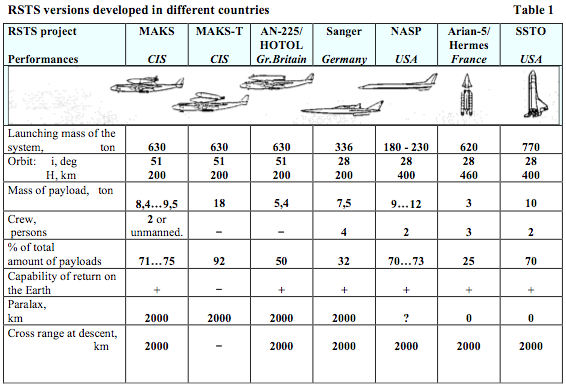
|
|
RSTS versions developed in different countries |

|
|
Figure 1. MAKS basic version with Orbiter and External Tank |

|
|
Figure 2. MAKS-T cargo version |
In parallel with the works on MAKS project, at NPO MOLNIYA the design studies on the concept of completely reusable Aerospace Plane (ASP) with LRE are conducted at different versions of start:
- horizontal start from a subsonic carrier-plane - ASP-D;
- horizontal start from a hypersonic booster-plane - ASP-H;
- vertical start with help of a reusable winged rocket booster with LRE - ASP-V;
- vertical start from ground single-stage-to-orbit ASP with LRE (of American launcher of SSTO type) - ASP-O;
- horizontal start with the help of ground-based accelerating trolley - ASP-R.
All these RSTS versions have passed the careful workout with results registration in the reports and technical proposals.
Completely reusable ASS with subsonic CP includes in its structure an aerospace plane (ASP-D) as the second stage, which has built-in tanks and LRE. Later on, such ASS was studied during the international research in the frame of AN-225/HOTOL-Interim study with participation of British Aerospace, ANTK Antonov and NPO MOLNIYA firms, and TsAGI and TsIAM institutes. Further development of this ASS version was continued in the project of Multipurpose Aerospace System, where it was considered as the third MAKS version (MAKS-M - see the paper 'The MAKS Multipurpose Aerospace System' in this book).
Completely reusable ASS can be created at the later stages on the experience of MAKS-OS and MAKS-Т partially reusable systems. The highest economic indices of such a system are gained in case of parallel maintenance together with the indicated basic MAKS versions.
In the ASP-D system (Fig. 3) the payload bay is located above the upper tanks' surface, and in AN-225/HOTOL-Interim and MAKS-M systems – in the inter-tank department.

|
|
Figure 3. Completely reusable ASP-D system |
On the example of ASP-D project with subsonic CP and completely reusable aerospace plane with LRE the analysis of influence of propellant type on main energy-mass launch characteristic was conducted. The versions with oxygen-kerosene engines of RD-120 type, perspective oxygen/hydrogen engines and three-component double-mode engines of RD-701 type were studied. The comparative launch characteristics of these three versions of the main propulsion unit (MPU) at a take-off mass of ASP-D of 250 tons are displayed in Tab. 2 for the reference circle orbit with the height of 200 km and inclination of 51°.
The advantages of ASP with oxygen-kerosene engines of RD-120 type include rather a small value of structural mass and high level of lift-to-drag ratio. But these advantages can not indemnify the losses of the injected mass connected to low value of oxygen-kerosene LRE specific impulse. At allocated load-lifting ability of CP, the payload mass in this version appeared negative. Only in case of essential improvement of kerosene LRE characteristics, it is possible to expect the increase of payload mass to one ton approximately. At using the subsonic planes as ASS carriers, the kerosene engines can be of interest only in SFV versions having separated units on the active launch leg, for example in the systems made under X-34 (USA) scheme. The low LRE specific impulse in such systems is indemnified by the effect of expendable blocks' dropping.
As it is visible from Tab. 2, the maximum total injected ASP mass is achieved in the version with perspective oxygen/hydrogen engines with high specific impulse. However, due to big mass of hydrogenous combustible at its low density, the structural mass in this case is maximal, which reduces the payload mass to a low level.
The optimum performances are achieved at using RD-701 engines, which have a high thrust in the first three-component operational mode at the start of launch, and a high specific impulse in the second mode at the end of the ascent, where only hydrogen and oxygen are spent. Owing to decreasing the hydrogen mass as compared to oxygen-hydrogenous LRE the structural ASP mass is reduced, and the gain in a structural mass exceeds the losses in total injected mass.
Similar results of the comparative analysis on LRE of different types were obtained later on by Prof. R. Parkinson from British Aerospace Corporation [2] and by specialist of Pratt and Whitney Corporation R. Joiner [3].
The version of ASP-D space system intended for inter-continental transportation of 52 passengers in sub-orbital ASP with rocket engines launched from AN-225 subsonic plane was also studied. The flight of such system consists of the following main legs. CP take-off with ASP on fuselage and climb, ASP separation from CP, ASP boost with the help of LRE, ASP flight outside of dense atmosphere along an elliptical trajectory, descent in atmosphere to the area of destination, non-powered runway landing. Throttling LRE thrust for holding acceptable g-load equal to 2 was stipulated. For 2.5…3 hours this system allows to transport the passengers into any point of Globe. The maximum duration of the flight leg in weightlessness is 30 min.
AN-225/HOTOL-Interim project close to ASP-D and MAKS-M was studied at first on the basis of the single-stage ASP HOTOL configuration intended for horizontal start from the ground with the help of a combined propulsion unit. The expertise, conducted in NPO MOLNIYA, has shown that at air start from CP, such ASP HOTOL version due to its high structural mass can not reach the orbit even without a payload. It was explained by an oversized wing, designed on conditions of start from the ground, non-optimal layout of tanks and other disadvantages of the parent version of the second stage. After the second phase of team workings it was shown that version ASP with three-component engines and with minimum mass of wing, undercarriage, tanks and other configuration items had optimum performances and was capable to inject into a low-height orbit with inclination of 51° up to four tons of payload.
ASS with a hypersonic booster-plane and ASP (ASP-H) was studied in NPO MOLNIYA within the framework of KHOLOD theme and during the preparation of technical proposal on completely reusable ASP with different types of start (Fig. 4).
Presence of a group of specialists from DB named after Mikoyan has allowed to conduct the research on a booster-plane with a combined propulsion unit using the experience of works both on supersonic fighter-airplanes and on SPIRAL space system.

|
|
Figure 4. ASP-H with hypersonic booster-plane |
SP-H two-stage system is close by its concept to the known Sanger German project with HYTEX hypersonic aircraft as the first stage.
Recent researches under the Sanger project, as well as on the NASP aerospace plane, are turned off. The versions of reusable launchers with LRE are accepted in the USA and Western Europe as base on the nearest perspective. Apparently, the creation of systems with combined propulsion unit is removed for more remote period because of the high projects cost, necessity of complicated technologies development and high scale of technical risk.
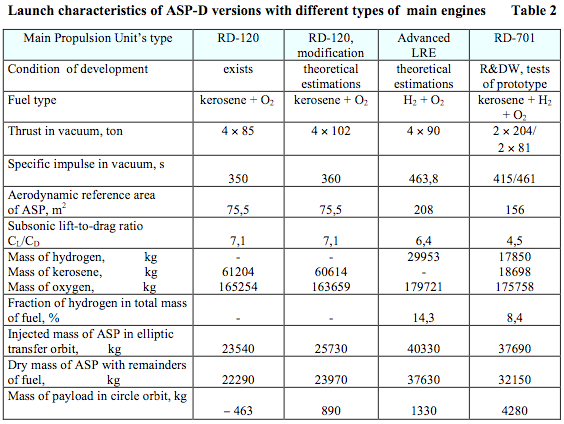
|
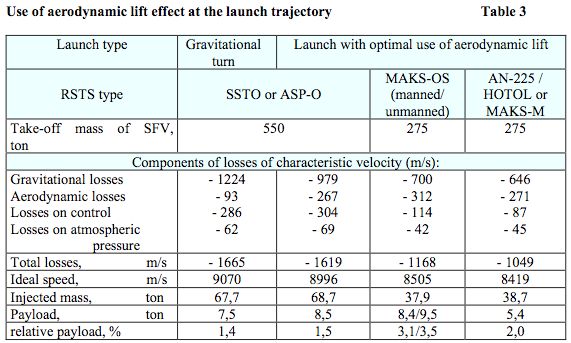
|
Completely reusable two-stage RSTS of vertical start (ASP-V) studied at NPO MOLNIYA reminds a known system Shuttle-2 (USA) and similar projects of NPO ENERGIA (Fig. 5).
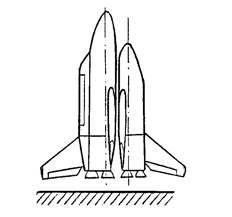
|
|
Figure 5. 2-stage RSTS (ASP-V) |
Two versions of batch connection of a winged booster of 1-st stage and ASP injected into an orbit are considered: connection by bottom surfaces of two FV (the scheme was conventionally named 'hands') and arrangement of the 2-nd stage above the top of booster fuselage ('biplane' scheme). In the first version, both flight vehicles had only one fin, like BURAN, in the second version, two fins on wing edges were stipulated. Both versions had rather close characteristics of injection into an orbit.
In considered RSTS, three-component engines of 1-st and 2-nd stages are started at start and operate simultaneously with low-over of fuel from the tanks of the 1-st stage to the engines of the 2-nd stage.
At Mach number in the point of separation ~3.5 non-powered booster of the 1-st stage return to the airfield is provided located near the point of start. One of this system disadvantages is the essential non-equilibrium of booster return trajectory, which results in large aerodynamic loads on the construction. Such trajectory is close by stress to a trajectory of emergency return of BURAN, occurring in case of its rapid separation from ENERGIA launcher. Under such circumstances, the task of guaranteed return is complicated by the essential influence of disturbances: wind and deviations of thermodynamic parameters of atmosphere.
In NPO MOLNIYA, the alternative versions of two-stage launch systems of vertical start, in particular, the system with a reusable winged booster of the 1-st stage on the basis of BURAN Orbiter design and with expendable rocket block as the 2-nd stage booster were also studied.
Single-stage ASP of vertical start and horizontal landing (ASP-O) was studied together with NPO ENERGOMASH. The similar project (SSTO) is accepted now as the base in the American program of RLV reusable launch vehicle, which provides the study of three concepts:
- conical SSTO of Delta-Clipper with vertical rocket landing;
- winged SSTO of vertical start and horizontal landing;
- SSTO of 'lifting body' scheme of vertical start and horizontal landing.
As is known, the SSTO 'lifting body' scheme project, designed by Lockheed Corporation and providing advanced creation of a diminished experimental FV-demonstrator X-33, won in the competition.
The optimal performances of ASP-O single-stage launcher (Fig. 6) are achieved at using three-component LRE.
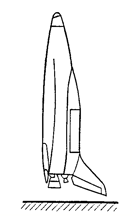
|
|
Figure 6. ASP-O project (SSTO) |
It is necessary to note that three-component engines provide greater advantage in the ASP-O and SSTO projects (as compared to dual-component Space Shuttle SSME), than in two-stage systems. At fixed ASP take-off mass of 550 tons, dry mass of the launcher is reduced by 18%, which results in increase of payload mass from about two to ten tons. The very close results of three-component LRE for SSTO efficiency assessment were obtained in the USA [4].
The launch characteristics of the winged single-stage launcher can be improved at the expense of using the aerodynamic lift capacity at implementation, after the vertical take-off, of more flat trajectory with smaller fuel expenditures. In Tab. 3, the main mass characteristics and components of losses in characteristic velocity are shown at SSTO launch under the scheme, conventional for the vertically starting launcher with gravitational turn and with optimal usage of aerodynamic forces. At take-off mass of SSTO equal to 550 tons, the flat launch due to the essential decrease of gravitational losses allows to increase payload mass by more than 10%.
In Tab. 3 the data for horizontally launched systems (MAKS and AN-225/HOTOL) are shown for comparison.
As compared to MAKS second stage, HOTOL-Interim has the higher lift-to-drag ratio that decreases the requirements to intensity of CP pre-launch maneuver and provides more flat injection trajectory with smaller losses of characteristic velocity. It results in increase of injected mass into a low-height orbit. But on payload mass the completely reusable ASS loses as compared to MAKS system because of the greater fraction of the structural mass in injected mass, and the loss in payload mass increases with the increase of the orbital height. The results in Tab. 3 correspond to the reference orbit with the height of 200 km and inclination of 51°.
Table 3 displays the energetic contribution of the carrier-plane as the first stage of launching system. This contribution to launch is not explained only by the initial speed (of approximately 190 m/s). Gravitational losses decrease results in the ideal speed gain of 560…650 m/s as compared to the conventional vertical start, and the gain is higher at the increase of the lift-to-drag ratio of the 2-nd stage of ASS.
Single-stage winged launcher with LRE, started horizontally from the airfield accelerating trolley (ASP-R) has appeared the least attractive of all studied versions. Essentially, such RSTS (Fig. 7) is a two-stage design since the accelerating unit actually represents the ground-based booster of the 1-st stage. The disadvantage of such start consists in additional energy expenditures connected with ASP injection into the plane of launch, when the direction of runway does not coincide with the launch azimuth. Naturally, the start from the mobile ground-based platform decreases the undercarriage mass. But ASP wing in this case is calculated under the conditions of horizontal start from the ground, as against SSTO and MAKS and AN-225/HOTOL-Interim systems, in which the size of a wing of a reusable orbital stage is determined according to the landing conditions.
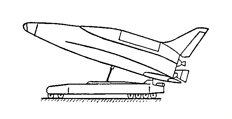
|
|
Figure 7. ASP-R with accelerating unit |
Single-stage ASP-R launched horizontally from the mobile platform can represent a practical interest, if this platform is not a ground-based 'cart' or 'trolley', but AN-225 airplane. But in this case ASP-R is transformed into a system of ASP-D type.
At preparation of the technical proposal on reusable winged ASP, the horizontal type of start was studied at different values of Mach number (М0) and flight height (Н0) at the beginning of autonomous phase of launch of an aerospace plane with LRE:
- start ASP-R from the ground-based accelerating device at М0 = 0.5 and Н0 = 0;
- start ASP-D from the subsonic carrier-plane at М0 = 0.7 and Н0 = 8…9 km;
- start ASP-H from the hypersonic booster plane at М0 = 5.0 and Н0 = 25…30 km.
The dependence of payload mass mpl on the radical square from specific mechanical energy E0 at the start of autonomous phase of launch at fixed launching ASP mass of 250 tons is displayed in Fig. 8.
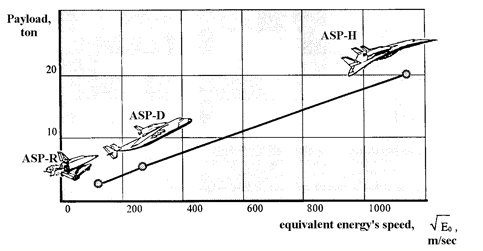
|
|
Figure 8. Dependence of payload mass on specific energy in the point of start |
This practically linear dependence displays that the start from the ground-based accelerating device essentially loses to the air start by power capabilities. The hypersonic air start increases considerably the payload mass as compared to the start from subsonic CP. However, implementation of projects of ASP-H type is the task of more long-term future, and at existing technological base the most promising path is the creation of a partially reusable MAKS system with an expendable ET, which provides as contrasted to ASP-D twice to increase the payload mass injected into a low Earth orbit inside payload bay of the reusable orbital plane.
Comparing now results of researches, corresponding to all the listed projects, we see once again that MAKS system represents the most reasonable compromising proposal for the nearest period. This project implementation could become the basis for future creation of completely reusable launching systems.
But, as any launching system, MAKS has perspectives of improvement of its basic performances in the process of aircraft and rocket-engineering technologies development. Application of new materials and onboard equipment will permit to decrease the dry mass of ET and OP. The characteristics' essential improvement can be reached in case of creation of a new special heavy HERACLES carrier-plane with weight-lifting ability up to 450 tons, which project is developed at NPO MOLNIYA. This plane (Fig. 9) is design according to 'tri-plane' scheme with two fuselages, between which the payload on the external attachment is placed: second stage of ASS, bulky commercial freights, cargo container with freights or removable passenger cabin.

|
|
Figure 9. Advanced HERACLES heavy carrier-plane (with cargo container) |
In case of HERACLES application, a completely reusable aerospace system of ASP-D type can provide the same payload mass, as the MAKS partially reusable system with AN-225 carrier-plane.
Design-Ballistic Researches under MAKS Project
One of the first projects of an aerospace system was researched at NPO MOLNIYA in 1977…1978 within the framework of ROSA R&DW. This ASS represented a subsonic carrier-plane and the second stage consisting of a small orbital plane (OP) of 'lifting body' scheme, in tandem joint with a rocket booster (RB). The second stage (RBOP = RB + OP) reminded very much the second stage of SPIRAL system. Later on, this scheme was studied within the frames of works on ASS-49 and BIZAN systems, underwent various changes and eventually was transformed into the now widely known MAKS project on the basis of AN-225 heavy carrier-plane. The detailed description of ASS-49 and BIZAN systems is made in article 'Two-Stage ASS of Horizontal Start' of this book.
A disadvantage of the scheme with RBOP was the presence alienated fields at the distance of approximately 2000 km from the point of start for drop of expendable rocket booster. In the now known MAKS scheme, the external fuel tank is dropped in the antipodal region of the World Ocean.
The higher scale of MAKS reusability MAKS as compared to ENERGIA-BURAN system is achieved due to the absence of expendable rocket booster at the first stage, instead of which CP is used, and arrangement of the main LRE on the reusable orbital plane itself.
Certainly, the higher economic indices, as contrasted to conventional launchers, is not a sole advantage of ASS with subsonic CP. The available CP ranges, in particular, with using the air refueling, permit to depart to the zone of southern latitudes and to provide start directly in the plane of near-equatorial orbits. This new quality of the launching system is especially valuable for Russia and other countries with a similar geographical position.
The air start mobility provides also the second important advantage - high efficiency of injection into the scheduled orbit and docking with the orbital object.
Absence of alienated fields on the ground and application of ecologically pure components of propellant increase the attractiveness of MAKS concept.
Certainly, the now known form of MAKS has not appeared immediately. The path of search, doubts, errors and finding the optimal solutions was long. The accumulated experience of designing on such complicated system and creation of extensive cooperation between the organizations participating in these works are of great value for the future of domestic aircraft and space-rocket branches.
The major question in formation of MAKS system configuration was selection of LRE for the main propulsion system. Already at the early stages of researches on ASS, it became clear that kerosene LRE do not provide the required level of payload mass, because of low specific impulse. To the beginning of the stage of draft designing, the general configuration of MAKS was formed with three oxygen/ hydrogen NK-45 engines developed, by Samara NPO TRUD with thrust in vacuum of 90 tons each. The take-off mass of the second stage was of 250 tons, maximum payload mass on the orbit with a height of 200 km and inclination of 51o was 7 tons. The cycle of researches was conducted later, which have shown that the best characteristics of MAKS launch are achieved in case of application of the three-component dual -mode RD-701 engine. The gain as compared to the oxygen/hydrogen engines of NK-45 type in three-component LRE version is achieved, despite of decrease of average over the trajectory specific impulse, as a consequence of essential decrease in the hydrogenous combustible and external fuel tank mass. Besides, being the engine of a new generation, RD-701 has a lower specific mass. Three-component LRE has allowed to reduce ET geometrical sizes and to improve aerodynamics of the MAKS second stage. Together with NPO ENERGOMASH, the optimization was conducted on hydrogen percentage in propellant consumption and on ratio of the thrust levels at the first and second modes of RD-701 operation.
The task of selection the MAKS second stage optimum layout, which consisted of two objects - external fuel tank (ET) and orbital plane (OP or Orbiter), was very difficult. Versions with arrangement of the oxidizing agent in the forward part of ET were considered at the beginning. In this case because second stage of MAKS (OPET = OP + ET) had excessive static stability. For decreasing the OPET aerodynamic longitudinal moment on diving it was necessary to fold completely the declined outer wing consoles of OP, in order that they did not create the lift affixed in a rear part of OPET. However, such solution contradicted to the already known principle of using the aerodynamic lift at the space systems launch. In this case the very high values of trajectory angle (of 40…45o) were required at the moment of OPET separation from carrier-plane, because of low lift-to-drag ratio of the 2-nd stage. Trajectory inclination at such angles could be provided only due to the prolonged LRE functioning until separation or with the help of additional LRE placed in the tail part of carrier-plane. At that in order not to spend a lot of fuel from ET before separation, it was necessary to install additional tanks with rocket propellant components inside the carrier-airplane. The developers of carrier-plane raise an objection against such solution.
One variant to solve the problem was the installation of lifting aerodynamic surface (small destabilizing wing) at the nose of external tank 'canard'. This has allowed to decline the outer orbiter's wing consoles at an angle of approximately 45o from vertical plane and to indemnify the weight of the forward wing at the expense of increase in the OPET mass injected into an orbit. The forward wing on ET don't only increase the aerodynamic lift by itself, but also allows using the lift from the orbiter's outer wing consoles. Such solution had a number of essential disadvantages: stall from the forward wing influenced on streamlining flow on outer orbiter's wings, the bending moment which acted on the ET construction was increased, ET structural mass and cost increased too.
The alternate solution offered by 10 Department of TsAGI, was reduced to the project of so-called 'Siamese-Twins Tank', which had three parallel cylindrical sections. Practically flat bottom surface of such external tank created a larger lift as a lifting body vehicle. It was offered to place the orbiter's nose into a niche in the rear part of the tank. In this case the OPET had a very good aerodynamic characteristics and flight performance. The comparative analysis of launch trajectories of different OPET versions has shown that the version with 'Siamese-Twins Tank' had minimum total losses of characteristic velocity, and accordingly the maximum injected mass. Nevertheless, the proposal of TsAGI was not accepted, since the structural mass of such tank appeared much above any alternative ET versions.
It was necessary to find the version with the minimal mass of external tank, being the sole expendable element of the system. The solution offered by the Deputy General Designer Ya.I. Seletaky was very simple: to place oxygen in the rear part of ET. In this case the center-of-gravity position displaced back and the orbiter's outer wing consoles of OP could be declined practically to a full angle without introduction of destabilizing wing at the ET nose. The mass of external tank was reduced at such layout because of decrease in the bending moment, acting on the tank's construction. For the increase of the tank ability to withstand against external aerodynamic loads, the increased pressure inside ET was stipulated. These solutions, alongside with the application of aluminum-lithium alloys, give us opportunity to achieve low values of the relation of tank dry mass to the mass of fuel.
Many efforts were spent to find an optimal relative positional of orbiter and external tank within integrated structure of the MAKS 2-nd stage. There is an essential disadvantage of the basic concept with orbiter's arrangement above the conical rear part of the external tank. In this case the orbiter's bottom surface and wing are arranged under a large angle to the ET centerline, which decreases the lift-to-drag ratio of the MAKS 2-nd stage (OPET). More over, in this case a large angle of LRE thrust vector inclination downwards relative to the ET axis unfavorably influences the energy expenditure and loads exercised on OPET at the launch.
With the purpose to find the way to eliminate the indicated disadvantages, the parametric calculations with variation of an attachment point of OP nose on ET surface were conducted. For acceleration of work, the program module of OPET aerodynamic characteristics' calculation was connected to STARTV program of trajectory calculation.
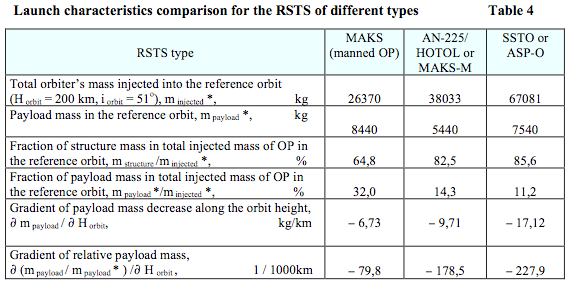
|
The results of researches have shown that moving OP along the upper surface of ET does not give any noticeable improvement of characteristics. The optimum by aerodynamics OPET layout was obtained at arrangement of the OP nose below under the rear part of ET. The second stage in this case reminds a barge with the towing vehicle-thruster (among aerodynamics and ballistics specialists the scheme has received a name 'Mole'). The gain in main flight performance and aerodynamic loads of such scheme was amazing. Due to the increase of lift-to-drag ratio and optimal direction of LRE thrust along the ET axis the payload mass increase of approximately by 1.5 tons was achieved. In such scheme, the balancing characteristics and characteristics of stability and controllability were improved.
Despite of these impressive advantages, the OPET of 'Mole' scheme was rejected, though it was registered as invention.
The reason was that while considerably improving the characteristics of nominal flight, the 'Mole' scheme has resulted in complicating many processes in abnormal situations: more complicated has appeared the emergency separation of OP and ET, serious difficulties arose in designing the system of ejected seats for the crew. There were other disadvantages, in particular, approximation of LRE jet to the surface of the carrier-plane. Because of these problems it was necessary to refuse from the aerodynamically optimal layout of the 'Mole' OPET. As a result of overall analysis of different factors, the former scheme of MAKS second stage with the upper arrangement of the orbit plane above the external fuel tank was taken as the basic.
One of the key features of MAKS project is the presence of an expendable external fuel tank, and this expands the area of accessible orbital heights. The fractions of the structure mass and payload mass in the total mass orbiter's injected mass are presented in Table 4. The values of payload mass decrease gradients over the orbital height are displayed for the following three projects: MAKS, AN-225/HOTOL-Interim or MAKS-M and single-stage winged launcher of vertical start (SSTO).
In Fig. 10, dependencies of relative payload mass on the orbit height mpayload/mpayload*, where mpayload* is the payload mass in the reference orbit with the height of 200 km, mpayload is the payload mass at Horbit > 200 km, are shown. The relations are displayed for three systems indicated in Tab. 4. The line for completely reusable ASS of AN-225/ HOTOL-Interim and MAKS-M type is for brevity designated as HOTOL.
At the indicated in Tab. 4 of fraction of structure mass in the total orbiter's injected mass, the MAKS orbiter can reach the orbit's height up to 1,500 km, ASP of HOTOL-Interim type ~ 820 km, and ASP of SSTO type ~ 680 km.
At calculation of economic indices of RSTS of different types, the comparison over a low reference orbit with height of 200 km is aberrant, as the ability of fulfillment of transport operations in working orbits is not reflected. In spite of the fact that SSTO and MAKS orbiter have close payloads in the circle orbit of Horbit = 200 km, the SSTO already at the height of 680 km shows a zero payload due to its high structure mass fraction (m structure / m injected = 85.6%), whereas at the indicated height (680 km) the MAKS orbiter loses only 35% of payload injected into the height of 200 km. It is explained by necessity to boost all the SSTO main fuel tanks' mass at orbital transitions, whereas in MAKS system the external fuel tank is dropped. As is visible from Fig. 10, at comparing RSTS, it is necessary to take into account not only the payload mass in the reference orbit mpayload*, but also the gradient of payload mass decreasing over the orbital height d mpayload/d Horbit.
m payload / m payload *, %
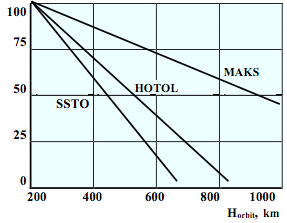
|
|
Figure 10. Influence of orbit height on relative payload mass |
The observed now decay of work in researches and developments on advanced space systems abroad is explained first of all by the high costs and high technical risks of creation of such systems as NASP, Sanger, HOTOL and others. As against of these projects, MAKS does not require the solution of such complicated technical problems, as creation of combined propulsion systems, which would combine the air-breathing and LRE modes. To the full extent using the experience of SPIRAL, BOR and BURAN programs, and leading positions of the domestic aircraft industry in the field of heavy transport airplanes, MAKS project looks the most real from all diversity of the researched RSTS concepts. The implementation of this project will cause decrease the cost of flights in space and hazardous affect on the environment, will open the direct access into orbits of low inclinations, will allow to solve efficiently a number of new space missions.
Reference
1. Filat'ev, A.S. The Optimal Space Vehicle Ascent Using Aerodynamic Forces. Cosmic Research, Vol. 29, No. 2. Consultanse Bureau, New York, 1994.
2. Parkinson, R.C., Webb, E. AN-225/HOTOL. AIAA/DGLR 5th International Aerospace Planes and Hypersonic Technologies Conference, Munich, Germany, 30 Nov. - 3 Dec. 1993.
3. Lozino-Lozinsky, G.E., Dudar, E.N., Joyner, R. Comparative Analysis Of Reusable Space Transportation Systems. AIAA 31th Joint Propulsion Conference, San Diego, USA, July 10-12, 1995.
4. Freeman, D.C., Stanley, D.O., Camarda, C.J., Lepsch, R.A. Single-Stage-To-Orbit - A Step Closer. 45th Congress of the IAF, Jerusalem, Israel, October 9-14, 1994.